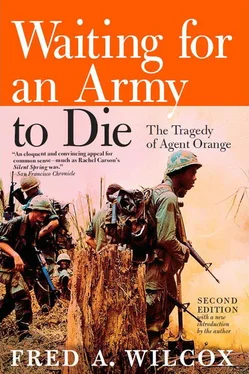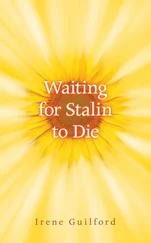(2) Rate of application . BLUE may be sprayed as received from the manufacturer without dilution, if desired. The recommended application rate for crop destruction is about 1 to 2 gallons per acre (app C). However, much higher use rates of BLUE are required to kill tall grasses, such as elephant grass or sugarcane because of the large masses of vegetation. For hand-spray operations, 2 gallons of BLUE diluted with water to make 50 gallons will give a solution that can be dispersed by hand at a rate equivalent to approximately 1 to 3 gallons of pure agent per acre.
(3) Effect on foliage . Enough BLUE applied to any kind of foliage will cause it to dry and shrivel, but the agent is more effective against grassy plants than broadleaf varieties. Best results are obtained when the plant is thoroughly covered, since the agent kills by absorption of moisture from the leaves. The plants will die within 2 to 4 days or less and can then be burned if permitted to dry sufficiently. BLUE in low dose rates can also prevent grain formation in rice without any apparent external effect. The plant develops normally but does not yield a crop. Spray rates higher than about one-half gallon per acre usually kill the crop. Although BLUE can produce relatively rapid defoliation, regrowth may occur again in about 30 days. Repeated spraying is necessary to provide a high degree of continuous plant kill.
(4) Safety precautions and decontamination . Normal sanitary precautions should be followed when handling BLUE. Although it contains a form of arsenic, BLUE is relatively nontoxic. It should not be taken internally, however. Any material that gets on the hands, face, or other parts of the body should be washed off at the first opportunity. Clothes that become wet with a solution of BLUE should be changed. Aircraft used for spraying this solution should be washed well afterward. When WHITE is added to BLUE, a precipitate forms that will clog the system. If the same spray apparatus is to be used for spraying agents WHITE and BLUE, the system must be flushed to assure that all residue of the previous agent is removed.
c. WHITE (Tordon 101) .
(1) Description . The active ingredients of agent WHITE are 20 percent picloram and 80 percent isopropylamine salt of 2,4-D. Active ingredients constitute about 25 percent of the solution. A surfactant is also present. WHITE is soluble in water, noncorrosive, nonflammable, nonvolatile, immiscible in oils, and more viscous than ORANGE at the same temperatures.
(2) Rate of application . WHITE usually should be applied at a rate of 3 to 5 gallons per acre on broadleaf vegetation. However, the rate may vary depending on the type of flora. Quantities required to control jungle vegetation may vary from 5 to 12 gallons per acre. This quantity exceeds the spray capability of most aircraft spray systems for a single pass. It is usually unfeasible in large-scale military operations to apply such large volumes. For ground-based spray operations, however, high volumes are necessary. Hand-spray operations cannot evenly cover a whole acre with only 3 gallons of solution. Three gallons of WHITE diluted to a 30-gallon solution can be more easily sprayed over an area of one acre. The manufacturer recommends diluting WHITE with sufficient water to make a 10-gallon solution for each gallon of agent.
(3) Effect on foliage . WHITE kills foliage in the same manner as ORANGE, since 80 percent of the active ingredient is 2,4-D. PICLORAM is more effective than 2,4-D, but acts slower. WHITE is effective on many plant species, and equal to or more effective than ORANGE on the more woody species. The material must be absorbed through the leaves. The water solution does not penetrate the waxy covering of leaves as well as oily mixtures and is more easily washed off by rain.
(4) Safety precautions and decontamination . WHITE exhibits a low hazard from accidental ingestion. However, it may cause some irritation if splashed into the eyes. Should eye contact occur, flush with plenty of water. Splashes on the skin should be thoroughly washed with soap and water at the first opportunity. Contaminated clothing should be washed before reuse. When WHITE is used in the same equipment as BLUE, all of the WHITE should be removed before using BLUE. The two agents produce a white precipitate that will clog spray systems.
COMPOSITION OF MILITARILY SIGNIFICANT ANTIPLANT AGENTS
| Antiplantagent |
Composition |
| ORANGE |
50% 2,4-D (n-butyl-2,4-dichlorophenoxyacetate); 50% 2,4,5-T (n-butyl-2,4,5-trichlorophenoxyacetate) |
| WHITE |
20% picloram (4-amino-3,5,6-trichloropicolinic acid); 80% 2,4-D (triisopropanolamine) |
| BLUE (Phytar 560G) |
3 pounds per gallon of water of: 65% of cacodylic acid (dimethylarsenic acid); 35% inert ingredients: sodium chloride, sodium and calcium sulfates, water |
AREA TREATED WITH HERBICIDES IN SOUTH VIETNAM 1962-1969
| Year |
Defoliation |
Crop Destruction |
| 1962 |
4,940 acres |
741 acres |
| 1963 |
24,700 |
247 |
| 1964 |
83,486 |
10,374 |
| 1965 |
155,610 |
65,949 |
| 1966 |
741,247 |
101,517 |
| 1967 |
1,486,446 |
221,312 |
| 1968 |
1,267,110 |
63,726 |
| 1969 (January–March) |
356,421 |
4,693 |
| - |
4,119,960 |
468,559 |
SOURCE: Military Assistance Command Vietnam Reports .
VA Memo Circulated on May 18, 1978
Directors, VA hospitals, domiciliary, outpatient clinics, and regional offices with outpatient clinics.
Subject: Potential exposures of veterans to chemical defoliants during the Vietnam War.
1. During the Vietnam War, herbicidal war chemicals were utilized for defoliation of vegetation. Recently concern has developed among some scientific and other groups that these chemicals may be capable of producing adverse health effects on individuals who were exposed to the herbicides. Because of their potential impact on a segment of the veteran population, the VA is attempting to develop accurate information on the health-related effects of the defoliants utilized during the Vietnam War.
2. The four defoliants utilized regularly were picloram, cacodylic acid, 2,4-D and 2,4,5-T. These were mixed in variable proportions and placed in color-coded storage drums which were identified as “Agent Orange,” “Agent White,” “Agent Blue,” and “Agent Purple.” A large number of studies performed on man and several animal species have demonstrated that the four herbicides have a low level of toxicity, both individually and when mixed. Furthermore they appear to be rapidly absorbed and completely excreted in both the human and the animal.
3. Humans exposed repeatedly to these agents may experience temporary and fully reversible neurological symptoms; however, the only chronic condition definitely associated with such exposure in humans is chloracne. Comprehensive animal studies performed under experimental conditions have demonstrated that very massive doses of these agents produce fatty degeneration of solid organs, gastrointestinal disturbances and thymic atrophy, all of which were reversible after withdrawal of the chemicals.
4. These studies have failed to confirm the suggestion in the Vietnamese medical literature that liver cancer, frequent abortions, and fetal birth defects occur among those exposed to the defoliants. In addition, no confirmation has been obtained for the experimental studies of one scientist who found that hepatic and pancreatic cancers followed prolonged exposure to one of the chemicals.
Читать дальше











